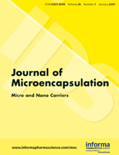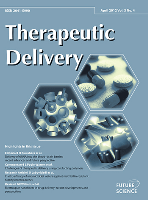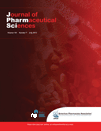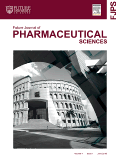
JOURNAL OF MICROENCAPSULATION
Scope & Guideline
Exploring the Future of Microencapsulation Technologies
Introduction
Aims and Scopes
- Pharmaceutical Applications:
The journal emphasizes the development of microencapsulation techniques for drug delivery systems, focusing on improving bioavailability, targeting, and therapeutic efficacy of various pharmaceutical compounds. - Food Science and Technology:
Research related to the encapsulation of flavors, nutrients, and probiotics in food products is a core area, aiming to enhance food stability, shelf-life, and health benefits. - Nanotechnology Innovations:
The journal highlights advancements in nanotechnology applied to microencapsulation, such as the use of nanoparticles and nanostructured carriers for enhanced delivery and efficacy of active ingredients. - Sustainable and Green Technologies:
A growing focus on eco-friendly and sustainable encapsulation methods, including the use of biodegradable materials and green synthesis approaches, reflects the journal's commitment to environmental considerations. - Interdisciplinary Research:
The journal encourages interdisciplinary studies that combine microencapsulation with various fields such as materials science, biochemistry, and biomedical engineering, fostering innovative applications.
Trending and Emerging
- Targeted Drug Delivery Systems:
There is a significant increase in research focused on targeted delivery mechanisms, particularly in cancer therapy, where encapsulation strategies are designed to improve the localization and effectiveness of treatments. - Biodegradable and Natural Materials:
Research into biodegradable and naturally derived materials for microencapsulation is on the rise, driven by the demand for environmentally friendly solutions and sustainable practices in various applications. - Microencapsulation in Vaccine Development:
The use of microencapsulation techniques in vaccine formulation is becoming increasingly prominent, particularly in the context of enhancing stability and controlled release of immunogenic components. - Smart and Responsive Systems:
The development of smart microencapsulation systems that respond to environmental stimuli (such as pH or temperature) is trending, allowing for controlled release and functionality in diverse applications. - Microencapsulation for Nutraceuticals and Functional Foods:
There is a growing interest in the encapsulation of bioactive compounds in nutraceuticals and functional foods, focusing on enhancing their stability, bioavailability, and health benefits.
Declining or Waning
- Traditional Encapsulation Techniques:
Methods such as simple spray drying and basic coacervation are appearing less frequently, as researchers increasingly seek more sophisticated and efficient techniques for encapsulation. - Non-Biodegradable Polymers:
There is a noticeable decline in the use of synthetic, non-biodegradable polymers for microencapsulation, likely due to growing environmental concerns and a shift towards sustainable materials. - Basic Formulation Studies:
Studies focused primarily on basic formulation without extensive application or in vivo evaluation are becoming less common, as the journal trends towards more comprehensive investigations that include efficacy and safety assessments. - Single-Component Systems:
Research centered around single-component encapsulation systems is declining, as there is a greater emphasis on multi-component systems and combinatorial approaches that enhance therapeutic outcomes. - Overly General Reviews:
The publication of broad, non-specific reviews is decreasing in favor of more targeted reviews that address specific technologies, applications, or emerging trends in microencapsulation.
Similar Journals

ADVANCED DRUG DELIVERY REVIEWS
Elevating Research in Pharmacology and Pharmaceutics.ADVANCED DRUG DELIVERY REVIEWS, published by ELSEVIER, is a leading journal in the field of pharmaceutical sciences, particularly acclaimed for its contributions to the disciplines of pharmacology, toxicology, and pharmaceutics. With an impressive 2023 Scopus rank of #1 out of 183 in its category, this journal is situated in the Q1 quartile, reflecting its high impact and the relevance of its published research. Since its inception in 1987, it has continually focused on the latest advancements in drug delivery systems, making it an indispensable resource for researchers, professionals, and students interested in the innovative developments that shape the pharmaceutical landscape. The journal aims to publish comprehensive and authoritative reviews that foster a deeper understanding of drug delivery mechanisms, technologies, and their clinical applications. Although it operates under a subscription model, the value it provides through rigorous peer-reviewed content ensures it remains an essential tool for anyone seeking to enhance their knowledge in this rapidly evolving field.

Therapeutic Delivery
Connecting Professionals to Pioneering Therapeutic ApproachesTherapeutic Delivery is a prestigious journal dedicated to advancing the field of Pharmaceutical Science, published by Newlands Press Ltd. Since its inception in 2010, this journal has become a vital resource for researchers and professionals alike, focusing on innovative drug delivery systems and therapeutic approaches that enhance patient care. With an impressive impact factor reflective of its credibility and scholarly influence, Therapeutic Delivery is currently ranked in the Q2 quartile and placed at Rank #64 out of 183 in the realm of Pharmacology, Toxicology, and Pharmaceutics, showcasing its prominence in the field. The journal operates with an Open Access format, ensuring that groundbreaking research is readily available to a global audience. Based in the United Kingdom, it publishes comprehensive articles that cover a wide spectrum of topics within pharmaceutical sciences, from molecular mechanisms to clinical applications, thus catering to both academic and professional readerships. Researchers, students, and industry professionals will find Therapeutic Delivery an invaluable platform for sharing insights and fostering advancements in therapeutic methodologies.

International Journal of Pharmaceutical Investigation
Elevating Standards in Pharmaceutical ScholarshipInternational Journal of Pharmaceutical Investigation, published by INPHARM ASSOC, PHCOG NET, is a premier platform dedicated to advancing the field of pharmaceutical sciences. With the ISSN 2230-973X and E-ISSN 2230-9713, this journal serves as a vital resource for researchers, professionals, and students focused on drug development, formulation, and efficacy. By fostering a rich discourse on innovative pharmaceutical practices and research breakthroughs, the journal plays a critical role in enhancing global health outcomes through groundbreaking scholarly work. The absence of open access allows for selective dissemination of high-quality content, promoting rigorous peer-review processes that uphold academic integrity. Featuring articles that span a diverse range of topics within pharmaceutical sciences, the International Journal of Pharmaceutical Investigation is committed to supporting the ongoing evolution of this dynamic field, making it an essential read for anyone engaged in pharmaceutical research and development.

Nanotechnology Science and Applications
Empowering Researchers with Open Access to Nanotechnology Insights.Nanotechnology Science and Applications, published by DOVE MEDICAL PRESS LTD, is a premier open-access journal dedicated to advancing knowledge in the fields of nanoscience and nanotechnology, particularly focusing on their applications in bioengineering, biomedical engineering, and pharmaceutical sciences. Since its inception in 2008, this journal has provided a platform for the dissemination of high-quality research that is rigorously peer-reviewed, ensuring that only the most impactful findings reach a global audience. With an impressive impact factor reflected in its recent categorization in the Q1 tier for Pharmaceutical Science and Q2 for Bioengineering and Nanoscience, it stands as a critical resource for researchers, practitioners, and students eager to explore the cutting-edge innovations within these rapidly evolving disciplines. The journal's commitment to accessibility and its robust indexing in Scopus—ranked highly in its respective categories—reinforces its importance as a leading forum for the exchange of scientific knowledge and the fostering of collaborative research in nanotechnology applications.

Journal of Materials Chemistry B
Exploring Innovative Pathways in Materials Science.Journal of Materials Chemistry B is a prestigious peer-reviewed journal published by the Royal Society of Chemistry, specializing in the latest advancements in the realm of materials chemistry. With a profound impact in the scientific community, this journal has achieved impressive Q1 quartile rankings in 2023 across several categories, including Biomedical Engineering, Miscellaneous Chemistry, Materials Science, and Medicine, illustrating its pivotal role in interdisciplinary research. Its impressive Scopus rankings further emphasize its widespread recognition, with notable placements in the top percentiles for various fields. Covering a broad scope of topics from novel materials for biomedical applications to innovative chemical synthesis techniques, the journal aims to promote knowledge exchange and foster collaborative research across disciplines. Although not an open-access journal, it offers a platform for researchers to share their findings and contribute to the evolving discourse within materials science. With a publication record spanning from 2013 to 2024, the Journal of Materials Chemistry B remains an essential resource for researchers, professionals, and students dedicated to exploring the frontiers of materials chemistry.

JOURNAL OF DRUG DELIVERY SCIENCE AND TECHNOLOGY
Catalyzing Breakthroughs in Drug Formulation and DeliveryThe Journal of Drug Delivery Science and Technology, published by Elsevier, stands at the forefront of pharmaceutical research, focusing on innovative drug delivery systems and technologies. With a robust impact factor reflected in its Q1 rating within the pharmaceutical sciences category, this journal is recognized for its high-quality contributions, ranking #30 out of 183 in the Scopus pharmacology and toxicology category (2023). Since its inception in 2004, the journal has been pivotal in disseminating groundbreaking research and advancements in drug formulation and delivery methodologies. Researchers and practitioners alike benefit from its comprehensive articles, which are accessible under open access options, ensuring widespread dissemination of knowledge. As it converges towards its 20th anniversary in 2024, the journal continues to enhance its impact on the scientific community, paving the way for future innovations in drug delivery.

Probiotics and Antimicrobial Proteins
Connecting Science and Health through Microbial InnovationsProbiotics and Antimicrobial Proteins, published by SPRINGER, is a pivotal journal dedicated to the exploration and advancement of research in the fields of microbiology, molecular biology, and molecular medicine. With a strong impact reflected in its Q2 categorization for 2023 across multiple disciplines, this journal serves as an essential platform for disseminating innovative findings related to probiotics, antimicrobial peptides, and their implications in health and disease management. Spanning its converged years from 2009 to 2024, the journal provides impactful insights that cater to a broad audience including researchers, healthcare professionals, and students who are eager to explore the intersections of microbiological science and therapeutic applications. While currently offering subscription access, the relevance and quality of the published articles ensure that it remains an indispensable resource for those seeking to stay at the forefront of microbial research and its practical applications.

JOURNAL OF PHARMACEUTICAL SCIENCES
Unveiling the science behind effective therapies and innovations.The JOURNAL OF PHARMACEUTICAL SCIENCES, published by ELSEVIER SCIENCE INC, stands as a cornerstone in the field of pharmaceutical sciences, offering a platform for innovative research and advancements since its inception in 1961. With an impressive Scopus Rank of #36 out of 183 in the Pharmaceutical Science category, this journal is recognized for its commitment to disseminating high-quality, peer-reviewed studies that significantly contribute to the realms of pharmacology, toxicology, and pharmaceutics. Holding a 2023 Q2 category quartile, it attracts a diverse readership encompassing researchers, industry professionals, and students eager to advance their understanding and expertise. While the journal is not open access, it ensures valuable insights in every issue, making it an essential resource for those dedicated to the evolving landscape of pharmaceutical research. With an impact factor that reflects its relevance and influence, the JOURNAL OF PHARMACEUTICAL SCIENCES continues to shape the discourse in its domain, fostering innovation and collaboration among scholars worldwide.

Food Hydrocolloids for Health
Pioneering Discoveries in Hydrocolloid ApplicationsFood Hydrocolloids for Health, published by ELSEVIER, stands at the forefront of research in the fields of food science, gastroenterology, nutrition, and pharmaceutical science. With an ISSN of 2667-0259 and an impressive positioning in the academic community, the journal is ranked Q1 in Food Science and Pharmaceutical Science, alongside Q2 rankings in Gastroenterology and Nutrition and Dietetics as of 2023. This journal serves as a critical platform for disseminating innovative findings related to the health benefits of food hydrocolloids, emphasizing their applications and efficacy in nutrition and medicine. Researchers, professionals, and students can access cutting-edge studies that promote the understanding of health outcomes derived from hydrocolloid-based foods. The journal’s international outreach from the Netherlands facilitates a diverse array of contributions, making it essential for those engaged in advancing knowledge within these dynamic disciplines.

Future Journal of Pharmaceutical Sciences
Transforming Research into Real-World Pharmaceutical ApplicationsThe Future Journal of Pharmaceutical Sciences, published by Springer, stands as a vital resource in the realm of pharmaceutical research and innovation. Recognized for its open access initiative since 2015, this journal promotes extensive dissemination of cutting-edge discoveries, fostering collaboration among researchers, industry professionals, and students alike. With an ISSN of 2314-7245 and an E-ISSN of 2314-7253, it aims to bridge the gap between laboratory research and practical applications in the pharmaceutical sciences. Although specific metrics like HIndex and Scopus ranks are currently unavailable, the journal's commitment to high-quality, peer-reviewed content positions it as a promising platform for advancing pharmaceutical science. By engaging with this journal, contributors and readers can participate in the vibrant discourse shaping the future of drug development, therapeutic strategies, and healthcare solutions.